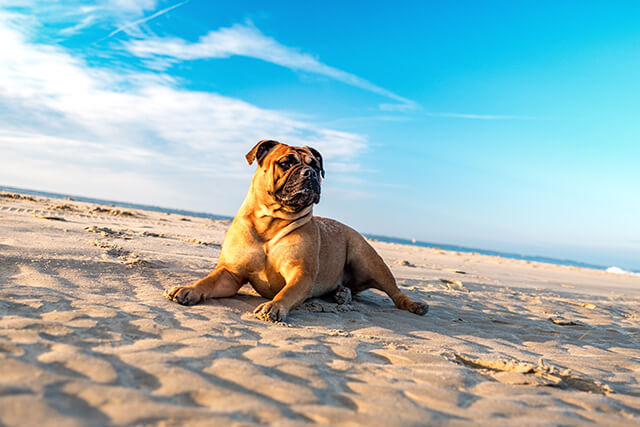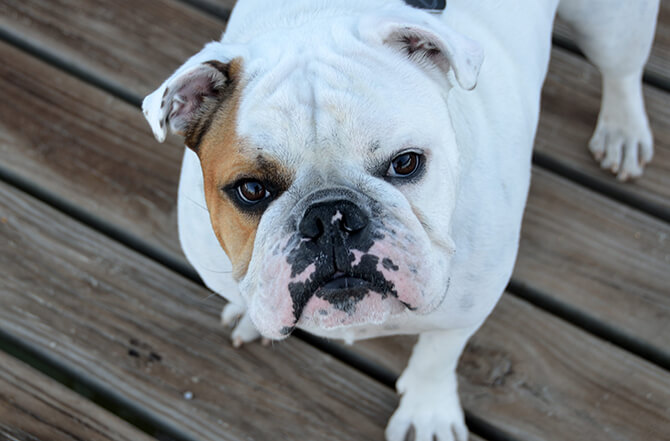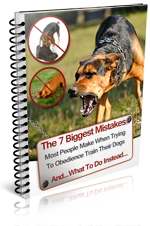
The American Bulldog (commonly mistaken for the American Pit Bull Terrier) is a stocky, muscular dog with a short easy-care coat and large, block-shaped head. The dogs were originally bred for catching livestock and protecting property, and thus have a strong genetic predisposition towards protectiveness and loyalty. Strong working dogs, the American Bulldog is not recommended for a first-time owner - without firm guidance and an owner's working knowledge of dog communication and psychology, they can run riot and simply be 'too much dog'.
Tips for Raising and Training an American Bulldog
- Due to the breed's background as a guard dog and general protector of property and livestock, American Bulldogs have an innate tendency towards suspicion of new people and animals. It's absolutely imperative that you socialize your Bulldog from a very early age with a large variety of people, animals, and positive new experiences. This will enable him to discriminate intelligently between friend and foe, and will prevent unfocused aggression towards anyone new.
- The breed has a very high energy drive and needs lots of exercise. You must be willing and prepared to involve your Bulldog in some sort of formal, organized training program that will stimulate and utilize his intelligent mind and strong, active body: for example, Schutzhund training, which is a demanding and interactive training method testing for endurance, physical strength, and intelligence, requiring and creating a strong bond between owner and dog; or advanced agility (obstacle courses) which requires a high degree of communication between you and your Bulldog.
- Formal obedience training to at least the intermediate level is a very good idea. A badly-trained adult American bulldog is a menace to animals and humans alike, as they have the extreme physical strength to back up any residual stubbornness. Obedience training will ensure that you and your dog both understand and respect one another.
- A high prey drive is a quality that breeders have deliberately emphasized in the American Bulldog when it was used primarily as working dog - it was necessary for the dog to chase and round up livestock independent of human instruction. As a result of this prey drive, some Bulldogs may chase and kill any small, fleeing creatures like cats or other small dogs. Provided that you introduce them slowly and while the dog is still young, things should be fine; although almost no Bulldog will tolerate the presence of another dog of the same sex in the house.
- These are intelligent dogs and require plenty of company and stimulation. It's not a good idea to leave an American Bulldog alone and unsupervised in your house or garden for long stretches of time, unless he has proven himself worthy of the privilege. His strong jaws can make a ruin of any household object or plant in a very short time indeed.
- You will need to supply him with a varied and tantalizing array of chew toys and 'smart' toys to keep him interested and content whenever you're not actively playing with or training him. Toys like the Buster cube are excellent - they releases treats every time they're rolled over a certain number of times; or anything indestructible from the Kong range will also do very well, such as the hollow toys which you fill with tempting foods like peanut butter or cheese. The dog will spend hours trying to extract every last morsel.
As you can see, this is a high-maintenance dog. American Bulldogs were never intended to be merely household pets; they're smart, demanding dogs with requirements of their own. If you have the energy and willingness to train your Bulldog sufficiently, and to spend plenty of time interacting with him, you'll have a fine companion: a loving, loyal, sweet-natured dog who also makes an outstanding guard and protector.
For more information on dog training, obedience, and preventing and handling behavioral problems such as aggression, subscribe to our FREE newsletter (just down the page)! It's packed with valuable, interesting information that no dog owner should be without - you can unsubscribe at any time just by clicking the link.


